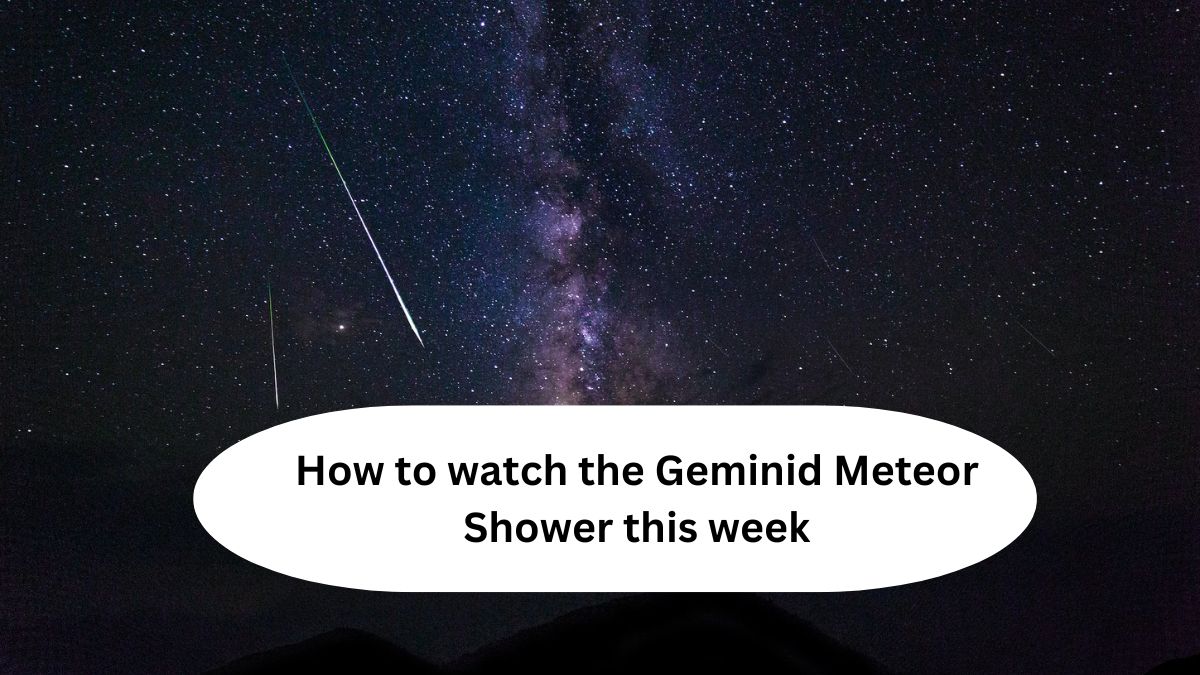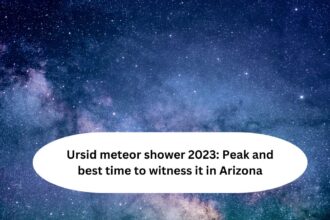The Geminid Meteor Shower, an annual celestial event, stands as a testament to the cosmic dance between Earth and an asteroid named 3200 Phaethon. Unlike most meteor showers originating from comets, the Geminids emanate from this rocky asteroid, adding a unique allure to their spectacle.
This phenomenon occurs as Earth traverses the path of debris left behind by 3200 Phaethon. As our planet crosses this trail of cosmic detritus, particles collide with our atmosphere at breakneck speeds, resulting in the mesmerizing streaks of light that define the Geminid Meteor Shower.
Importance of the Geminid Meteor Shower
The significance of the Geminid Meteor Shower lies in its remarkable characteristics that set it apart from other annual celestial displays. Notably, the Geminids boast a high meteor count, with the potential to dazzle onlookers with up to 120 meteors per hour during its peak. These meteors often exhibit exceptional brightness, making them a visual delight even for novice stargazers.
The brilliance and frequency of the Geminids contribute to their allure, attracting astronomers, astrophotographers, and nature enthusiasts alike. Its accessibility and reliability in delivering a spectacular show make the Geminids a highly anticipated event in the astronomical calendar.
Brief history of the Geminid Meteor Shower
The discovery and understanding of the Geminid Meteor Shower trace back to the relatively recent past in astronomical terms. Unlike ancient meteor showers observed for centuries, the Geminids entered the celestial scene in the mid-19th century, documented in the 1830s by observers in Europe and North America.
It wasn’t until the 20th century that the Geminid Meteor Shower gained recognition as a distinct and major annual meteor shower. Research and observations conducted in the 20th and 21st centuries gradually unveiled the origin of the Geminids, revealing their association with asteroid 3200 Phaethon.
The study of the Geminid Meteor Shower continues to evolve, with ongoing research shedding light on its composition, behavior, and the potential insights it offers into the composition of asteroids and their interactions with Earth’s atmosphere.
This relatively recent understanding of the Geminids has sparked increased interest and intrigue among scientists and enthusiasts, propelling it to the forefront of celestial phenomena worth observing and studying.
When and Where to Watch the Geminid Meteor Shower
Date and Time
The Geminid Meteor Shower typically graces the night sky around mid-December, reaching its peak between the 13th and 14th of the month. However, its visibility can extend a few days before and after this period, offering multiple opportunities for observation. To maximize your chances of catching this celestial spectacle, mark your calendar for this timeframe.
Timing is crucial for witnessing the peak of the Geminids. The optimal viewing window spans from late evening hours until the early hours of dawn, with the peak meteor activity often occurring around 2 AM local time. This timeframe provides the best opportunity to witness a higher concentration of meteors streaking across the sky.
Location
Selecting the right location significantly enhances the viewing experience. Find a spot away from urban light pollution, ideally in rural or remote areas with minimal artificial light sources. Escaping the city lights allows for an unobstructed view of the night sky, maximizing visibility and the number of meteors you can observe.
The ideal viewing location should offer a wide, open view of the sky without obstruction from tall buildings or trees. Look for elevated areas or hilltops that provide an expansive panorama of the heavens.
Best Practices for Viewing
Prepare for an extended observation session by dressing warmly, even if the weather seems mild. December nights can be chilly, especially during the early morning hours. Dress in layers and bring blankets or insulated sleeping bags to stay comfortable during the observation period.
As you settle in for the meteor shower, allow your eyes to adjust to the darkness for at least 20 to 30 minutes. Minimize exposure to artificial light sources, including phone screens, as they can hinder your night vision. Opt for red-light flashlights if needed, as they are less disruptive to night vision compared to white light.
Consider bringing along chairs, blankets, or reclining loungers for comfortable stargazing. Additionally, inform someone about your observation plans, especially if you’re venturing to a remote location, for safety purposes.
What to Expect During the Geminid Meteor Shower
Number of Meteors
The Geminid Meteor Shower is renowned for its prolific display of shooting stars. During its peak, it can produce an impressive meteor count, averaging around 60 to 120 meteors per hour under optimal conditions. This makes it one of the most active and reliable meteor showers annually.
Brightness of Meteors
One of the defining characteristics of the Geminids is the brightness of its meteors. Unlike some meteor showers that feature faint streaks, the Geminids often produce bright and long-lasting meteors. Their brilliance makes them easier to spot even against moderately light-polluted skies.
Colors of Meteors
Observers may witness a range of colors among Geminid meteors. These colors arise from the ionization of various elements present in the debris as it burns up in the Earth’s atmosphere. Common hues include white, yellow, green, and occasionally red, creating a mesmerizing visual display against the dark backdrop of the night sky.
Tips for Photographing the Geminid Meteor Shower
Equipment Needed
Capturing the Geminid Meteor Shower requires certain equipment to ensure successful astrophotography:
- Camera: A DSLR or a mirrorless camera with manual settings is ideal for capturing celestial events. However, even some advanced compact cameras can yield good results.
- Wide-angle Lens: Use a wide-angle lens with a fast aperture (f/2.8 or lower) to capture a larger portion of the sky and allow more light into the camera.
- Stable Tripod: A sturdy tripod is essential to keep your camera steady during long exposures, preventing blur in your photos.
- Remote Shutter Release or Intervalometer: This helps in minimizing camera shake during exposures.
- Extra Batteries and Memory Cards: Be prepared with spare batteries and ample memory cards, as extended shooting sessions can drain power and fill up memory quickly.
Camera Settings
Achieving optimal camera settings is crucial for capturing the Geminid Meteor Shower:
- Manual Mode: Set your camera to manual mode to have full control over settings.
- Wide Aperture: Use the widest aperture your lens allows (e.g., f/2.8) to gather more light, enabling you to capture fainter meteors.
- High ISO: Increase your ISO (usually between 800 to 3200) to make your camera more light-sensitive. Higher ISO settings may introduce more noise, so find a balance between brightness and noise levels.
- Long Exposure Times: Longer exposures increase the chance of capturing meteors. Start with exposures of 15 to 30 seconds and adjust as needed based on the ambient light and meteor brightness.
- Manual Focus: Set your lens to manual focus and adjust it to infinity. Take test shots to ensure the stars are in sharp focus.
Best Practices for Photographing
- Scout the Location: Visit your chosen location before the meteor shower to familiarize yourself with the surroundings and identify potential compositions.
- Frame Your Shot: Aim your camera towards the radiant point of the Geminid Meteor Shower, but keep in mind that meteors can appear anywhere in the sky.
- Use Bulb Mode or Continuous Shooting: For longer exposures exceeding your camera’s maximum shutter speed, switch to bulb mode or continuously shoot multiple shorter exposures to capture the meteors.
- Patience and Persistence: Astrophotography requires patience. Keep shooting multiple frames throughout the night to increase the chances of capturing meteors.
- Review and Adjust: Periodically review your shots and make adjustments to settings if necessary. Pay attention to exposure, focus, and composition.
Conclusion
The Geminid Meteor Shower, characterized by its high meteor count, dazzling brightness, and vivid colors, offers a captivating visual spectacle for sky watchers and astrophotographers alike. With up to 120 meteors per hour during its peak, it’s a remarkable event that draws enthusiasts to witness nature’s fireworks.
As you prepare to photograph the Geminid Meteor Shower, equip yourself with the right gear and settings outlined above. Remember, patience and persistence are key. Whether capturing a single spectacular meteor or a flurry of shooting stars, embrace the experience and relish the awe-inspiring beauty of the cosmos.






